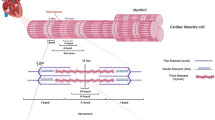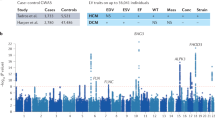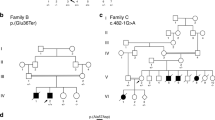Abstract
Heart failure is a leading cause of mortality in South Asians. However, its genetic etiology remains largely unknown1. Cardiomyopathies due to sarcomeric mutations are a major monogenic cause for heart failure (MIM600958). Here, we describe a deletion of 25 bp in the gene encoding cardiac myosin binding protein C (MYBPC3) that is associated with heritable cardiomyopathies and an increased risk of heart failure in Indian populations (initial study OR = 5.3 (95% CI = 2.3–13), P = 2 × 10−6; replication study OR = 8.59 (3.19–25.05), P = 3 × 10−8; combined OR = 6.99 (3.68–13.57), P = 4 × 10−11) and that disrupts cardiomyocyte structure in vitro. Its prevalence was found to be high (∼4%) in populations of Indian subcontinental ancestry. The finding of a common risk factor implicated in South Asian subjects with cardiomyopathy will help in identifying and counseling individuals predisposed to cardiac diseases in this region.
This is a preview of subscription content, access via your institution
Access options
Subscribe to this journal
Receive 12 print issues and online access
$209.00 per year
only $17.42 per issue
Buy this article
- Purchase on SpringerLink
- Instant access to full article PDF
Prices may be subject to local taxes which are calculated during checkout



Similar content being viewed by others
References
Reddy, K.S., Shah, B., Varghese, C. & Ramadoss, A. Responding to the threat of chronic diseases in India. Lancet 366, 1744–1749 (2005).
Joshi, P. et al. Risk factors for early myocardial infarction in South Asians compared with individuals in other countries. J. Am. Med. Assoc. 297, 286–294 (2007).
Liew, C.C. & Dzau., V. J. Molecular genetics and genomics of heart failure. Nat. Rev. Genet. 5, 811–825 (2004).
Flavigny, J. et al. Biomolecular interactions between human recombinant h-MyHC and cMyBP-Cs implicated in familial hypertrophic cardiomyopathy. Cardiovasc. Res. 60, 388–396 (2003).
Flavigny, J. et al. COOH-terminal truncated cardiac myosin-binding protein C mutants resulting from familial hypertrophic cardiomyopathy mutations exhibit altered expression and/or incorporation in fetal rat cardiomyocytes. J. Mol. Biol. 294, 443–456 (1999).
Gruen, M. & Gautel, M. Mutations in beta-myosin S2 that cause familial hypertrophic cardiomyopathy (FHC) abolish the interaction with the regulatory domain of myosin binding protein-C. J. Mol. Biol. 286, 933–949 (1999).
Freiburg, A. & Gautel, M. A molecular map of the interactions between titin and myosin-binding protein C. Implications for sarcomeric assembly in familial hypertrophic cardiomyopathy. Eur. J. Biochem. 235, 317–326 (1996).
Squire, J.M., Luther, P.K. & Knupp, C. Structural evidence for the interaction of C-protein (MyBP-C) with actin and sequence identification of a possible actin-binding domain. J. Mol. Biol. 331, 713–724 (2003).
McClellan, G., Kulikovskaya, I. & Winegrad, S. Changes in cardiac contractility related to calcium-mediated changes in phosphorylation of myosin-binding protein C. Biophys. J. 81, 1083–1092 (2001).
Sadayappan, S. et al. Cardiac myosin binding protein c phosphorylation is cardioprotective. Proc. Natl. Acad. Sci. USA 103, 16918–16923 (2006).
Niimura, H. et al. Sarcomere protein gene mutations in hypertrophic cardiomyopathy of the elderly. Circulation 105, 446–451 (2002).
Van Driest, S.L. et al. Sarcomeric genotyping in hypertrophic cardiomyopathy. Mayo Clin. Proc. 80, 463 (2005).
Waldmuller, S. et al. Novel deletions in MYH7 and MYBPC3 identified in Indian families with familial hypertrophic cardiomyopathy. J. Mol. Cell. Cardiol. 35, 623–636 (2003).
Thanseem, I. et al. Genetic affinities among the lower castes and tribal groups of India: inference from Y chromosome and mitochondrial DNA. BMC Genet. 7, 42 (2006).
The International HapMap Consortium. A second generation human haplotype map of over 3.1 million SNPs. Nature 449, 851–861 (2007).
Berul, C.I. et al. Ventricular arrhythmia vulnerability in cardiomyopathic mice with homozygous mutant myosin-binding protein C gene. Circulation 104, 2734–2739 (2001).
Niimura, H. et al. Mutations in the gene for cardiac myosin-binding protein C and late-onset familial hypertrophic cardiomyopathy. N. Engl. J. Med. 338, 1248–1257 (1998).
Kubo, T. et al. Lifelong left ventricular remodeling of hypertrophic cardiomyopathy caused by a founder frameshift deletion mutation in the cardiac myosin-binding protein C gene among Japanese. J. Am. Coll. Cardiol. 46, 1737–1743 (2005).
Rottbauer, W. et al. Novel splice donor site mutation in the cardiac myosin-binding protein-C gene in familial hypertrophic cardiomyopathy. Characterization of cardiac transcript and protein. J. Clin. Invest. 100, 475–482 (1997).
Moolman, J.A. et al. A newly created splice donor site in exon 25 of the MyBP-C gene is responsible for inherited hypertrophic cardiomyopathy with incomplete disease penetrance. Circulation 101, 1396–1402 (2000).
Vignier, N. et al. Cardiac myosin-binding protein C and familial hypertrophic cardiomyopathy: from mutations identification to human endomyocardial proteins analysis. Circulation 104 (Suppl.), II–1 (2001).
Yang, Q., Osinska, H., Klevitsky, R. & Robbins, J. Phenotypic deficits in mice expressing a MyBP-C lacking the titin and myosin binding domains. J. Mol. Cell. Cardiol. 33, 1649–1658 (2001).
Sarikas, A. et al. Impairment of the ubiquitin-proteasome system by truncated cardiac myosin binding protein C mutants. Cardiovasc. Res. 66, 33–44 (2005).
Okada, K. et al. 4-Hydroxy-2-nonenal-mediated impairment of intracellular proteolysis during oxidative stress. Identification of proteasomes as target molecules. J. Biol. Chem. 274, 23787–23793 (1999).
Bulteau, A.L., Szweda, L.I. & Friguet, B. Age-dependent declines in proteasome activity in the heart. Arch. Biochem. Biophys. 397, 298–304 (2002).
Sato, N. et al. A novel variant of cardiac myosin-binding protein-C that is unable to assemble into sarcomeres is expressed in the aged mouse atrium. Mol. Biol. Cell 14, 3180–3191 (2003).
Thangaraj, K. et al. Reconstructing the origin of Andaman Islanders. Science 308, 996 (2005).
Gupta, R., Misra, A., Pais, P., Rastogi, P. & Gupta, V.P. Correlation of regional cardiovascular disease mortality in India with lifestyle and nutritional factors. Int. J. Cardiol. 108, 291–300 (2006).
Acknowledgements
We thank all participants for making this study possible. We acknowledge the help of G.S. Selvam, C. Rajamanickam, R. Srinivasan, V. Madhavan, S. Madhavan, A.G. Reddy, A. Vanniarajan, P. Govindaraj, B.D. Gelb and Q. Long. P.S.D. was supported by Council of Scientific and Industrial Research – Senior Research Fellowship (CSIR-SRF) and P.N. by Department of Biotechnology (DBT). K.T. was supported by Council of Scientific and Industrial Research (CSIR) - Raman Research Fellowship and Y.X., G.T.P., Q.A., S.Q.M. and C.T.-S. were supported by The Wellcome Trust. T.S.R. received an Senior Research Fellowship (SRF) from Indian Council of Medical Research (ICMR), M.K. and A.B. were supported by Post Graduate Institute of Medical Education and Research (PGIMER), Chandigarh. S.S. received a post-doctoral training grant from the American Heart Association, Ohio Valley Affiliate, USA. D.R. is supported by a Burroughs Wellcome Career Development Award in the Biomedical Sciences.
Author information
Authors and Affiliations
Contributions
P.S.D., C.T.-S. and K.T. designed the study. A.B., J.M.T., P.V., A.R., C.N. and D.R.A. helped in recruitment of cardiomyopathy cases and controls. P.S.D., P.N., T.S.R., M.K. and D.S.R. screened the subject samples. P.S.D., S.S., Y.X., G.T.P., D.S.R. and K.T. performed the major experiments including genotyping, functional studies and sequencing. K.T., L.S., C.T.-S. and D.R. provided reagents for the study. K.T., C.T.-S., L.S., Q.A., S.Q.M., P.S., S.O., A.L.P., N.P. and M.B.R. helped in collecting and genotyping the various population samples. P.S.D. and K.T. drafted the manuscript with the help of C.T.-S. and D.R.
Corresponding author
Supplementary information
Supplementary Text and Figures
Supplementary Figures 1–8, Supplementary Tables 1–9, Supplementary Methods and Supplementary Note (PDF 3620 kb)
Rights and permissions
About this article
Cite this article
Dhandapany, P., Sadayappan, S., Xue, Y. et al. A common MYBPC3 (cardiac myosin binding protein C) variant associated with cardiomyopathies in South Asia. Nat Genet 41, 187–191 (2009). https://doi.org/10.1038/ng.309
Received:
Accepted:
Published:
Issue Date:
DOI: https://doi.org/10.1038/ng.309



